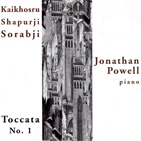Toccata No. 1
Jonathan Powell (piano)
Altarus Records: AIR-CD-9068 (2003)
Web page for Altarus Records

Duration: 74:54
Track listing
- Track 1-3: Toccata No. 1 (74:54)
- Track 1: I Preludio-corale – II Passacaglia (45:28)
- Track 2: III Cadenza-figurale (3:06)
- Track 3: IV Fuga – V Coda-Stretta (26:19)
Reviews
- “This 75-minute disc is devoted to a single work of Sorabji, and a very fine example indeed it is of the sort of thing he is, or was, principally known for before recent performances of early rhapsodic quasi-expressionistic works, lighter pieces and extended langorous tropical-mood works began to demonstrate that the expressive range of this extraordinary figure in 20th-century music was wider than even his long-time admirers had realised. This is to say that the First Toccata, from a couple of years before Opus Clavicembalisticum, has a certain amount in common with that watershed in Sorabji’s output. The quicksilver cadenza will certainly call to mind the fantasia and cadenzas in OC, while the fugues, culminating in the anticipated massive and apocalyptic coda-stretta, are also of the type familiar from other large-scale mature works of the composer. It has to be said, though, that Sorabji never repeated himself, and the extent to which all his fugues — which typically share unusually long-breathed subjects of similar construction, very comprehensively worked — have an unique character, is truly remarkable. The first, and longest, section of the work is the chorale prelude and passacaglia — the latter putting the theme through every possible pianistic device in a half-hour so concentrated it feels like five minutes. The chorale prelude is unlike anything else of Sorabji’s that has so far been recorded; slow-moving in even eighth-notes, spare of texture except for some gorgeous moments of harmonic resolution, it harks back to severe pre-classical forms in its austerity. Altogether a fascinating work, providing yet another view of the development of this unique figure in 20th-century music.” (Records International)
 Duration: 74:54
Duration: 74:54
